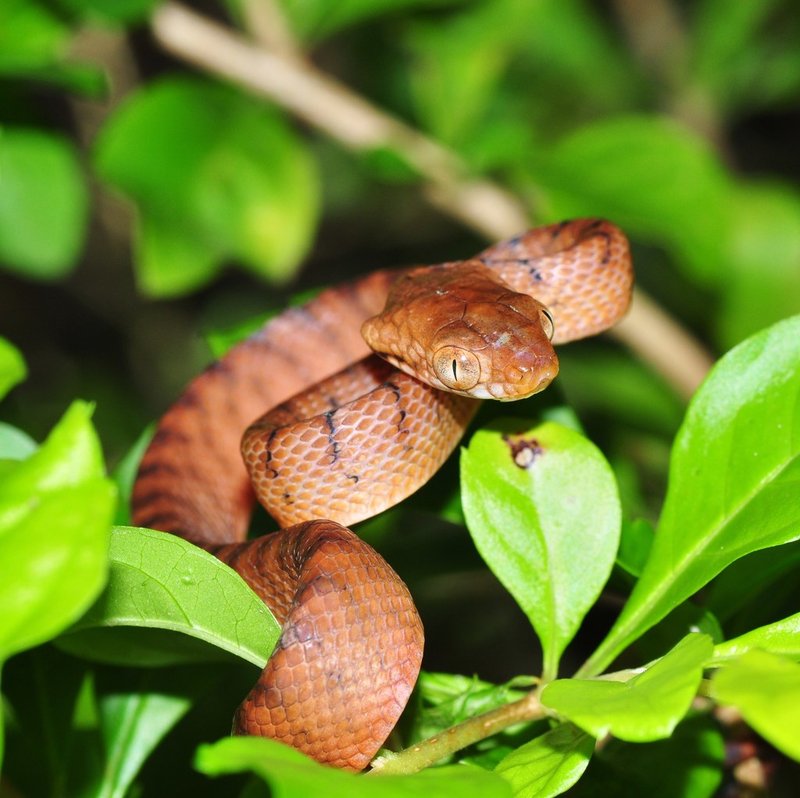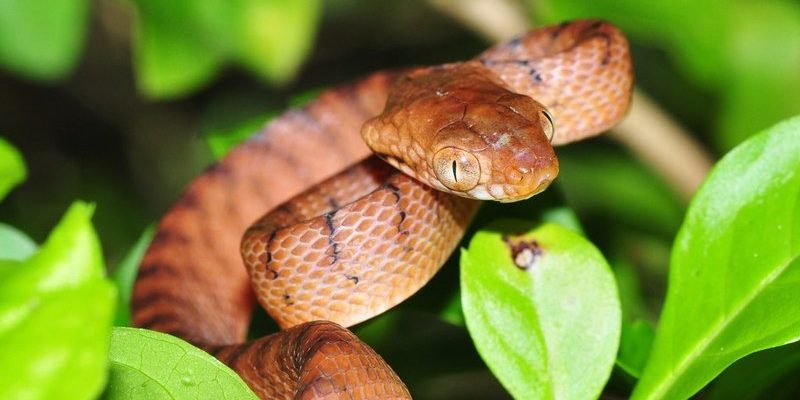
The Brown Tree Snake, a fascinating reptile found mainly in the Pacific region, is not just another snake—it’s a creature teeming with unique qualities and a rich history. Imagine wandering through a lush rainforest, sunlight streaming through the canopy, and suddenly spotting this slender, agile snake slithering effortlessly among the branches. With its striking patterns and behaviors, it’s easy to see why this snake captivates both animal lovers and researchers alike.
You might be wondering, what makes the Brown Tree Snake so special? Well, aside from its beautiful coloration, known for shades of brown, green, and gold, this snake has quite the reputation. Originating from New Guinea and several nearby islands, it made its way to Guam, where it became infamous for its impact on the local ecosystem. But there’s much more to this serpent than just its environmental influence—it plays an important role in its native habitats and displays intriguing characteristics that make it a subject of study.
Physical Characteristics
The Brown Tree Snake can grow anywhere from three to seven feet long, and its size can depend on its specific location and environmental conditions. This snake is characterized by its slender body, which allows it to navigate through trees and other dense vegetation with remarkable ease. Its skin features a unique pattern of spots or bands, often giving it an appearance that helps it blend into the natural surroundings, making it an effective predator.
One of the fascinating aspects of the Brown Tree Snake is its color variation. In some regions, they might appear more olive or yellowish, while in others, they can take on a darker brown hue. This variation can be crucial for camouflage, enabling them to avoid detection by both prey and predators. Speaking of their diet, these snakes are versatile eaters, preying on birds, small mammals, and even lizards, showcasing their adaptability in various settings.
Habitat and Distribution
Brown Tree Snakes primarily inhabit tropical forests, where they enjoy the warmth and abundance of food sources. They can be found in trees, shrubs, or even on the ground, depending on their mood or prey availability. This adaptability to different layers of the forest canopy means they’re often on the move, searching for food or a suitable place to rest. Their natural habitat ranges from New Guinea to the Solomon Islands, but they have also established populations in other areas, such as Guam. Here’s where things get interesting: their introduction to Guam led to significant ecological changes that impacted local wildlife.
The impact of the Brown Tree Snake on Guam’s ecosystem has been profound. When they arrived, they became invasive, preying on native birds and small mammals that had no prior defenses against such a predator. This led to a dramatic decline in native species and sparked conservation efforts to protect the island’s unique biodiversity. It’s a striking example of how the introduction of a single species can ripple through an ecosystem.
Diet and Feeding Behavior
When it comes to diet, the Brown Tree Snake is an opportunistic feeder. This means they will eat whatever is available and easiest to catch. Their main diet consists of small birds, lizards, and mammals. They are known for their skillful climbing abilities, which allow them to hunt in trees and snag unsuspecting birds from their nests. Imagine them silently coiling around a branch, waiting patiently for the perfect moment to strike—it’s a master class in patience!
Interestingly, these snakes are also nocturnal hunters, meaning they prefer to hunt during the night when their prey is most active. Their keen sense of smell helps them detect the scent trails left by potential meals, guiding them through the underbrush and into the trees. You might find it engaging to know that they can also eat whole prey, swallowing smaller animals down in one go. It’s a fascinating process, allowing them to maximize their hunting efficiency.
Behavior and Reproduction
Brown Tree Snakes are known for their unique behavior, which combines skilled climbing with relative shyness. While they can be aggressive if threatened, they generally prefer to retreat rather than confront dangers. This makes them fascinating subjects for observation, as you might catch a glimpse of their sleek bodies gliding through the branches. They also exhibit interesting social behaviors during the mating season, when males may engage in combat to win over a female. It’s a wild dance of nature that showcases both strength and agility.
Speaking of reproduction, Brown Tree Snakes typically breed in the spring. After mating, the female lays between five to twenty eggs, which she will then abandon. The eggs hatch after about two months, resulting in tiny versions of their parents that are independent from day one. It’s remarkable to think about how these little snakes will immediately begin the hunt for food, a daunting task for creatures so small!
Conservation Status
The conservation status of the Brown Tree Snake varies by location. In its native habitat, populations are relatively stable, but their introduction to Guam has led to significant ecological concerns. As an invasive species, they’ve caused numerous native birds to become endangered, prompting conservationists to take action. Efforts are ongoing to control their population on Guam, through various methods including trapping and public awareness campaigns.
It’s essential to recognize that while the Brown Tree Snake is often viewed negatively due to its invasive status in some areas, it also plays a vital role in its native ecosystems. Preserving the balance of these ecosystems is crucial. Educational programs and research into this snake’s behavior can help inform strategies that protect local wildlife while understanding the intricate web of nature.
Interesting Facts
| Scientific Name: | Boiga irregularis |
| Length: | 3 to 7 feet |
| Diet: | Birds, small mammals, lizards |
| Habitat: | Tropical forests |
| Lifespan: | Up to 20 years in captivity |
| Behavior: | Nocturnal, arboreal |
FAQ
What is the Brown Tree Snake’s habitat like?
The Brown Tree Snake thrives in tropical forests, where humidity and warmth are abundant. They can often be found basking in trees, coiled around branches, or hidden in dense foliage. Their ability to adapt to various environments within the forest canopy allows them to hunt efficiently and evade predators.
How does the Brown Tree Snake hunt?
This snake is a skilled predator, using its ability to climb and blend into its surroundings. They often wait patiently for the right moment to strike at unsuspecting birds or small mammals. Their sharp sense of smell also assists them in locating prey, making them effective nocturnal hunters.
Are Brown Tree Snakes dangerous to humans?
Generally, Brown Tree Snakes are not considered dangerous to humans. They are more inclined to flee when approached. While they can bite if threatened, their bite is not venomous, but it can cause discomfort. It’s always best to admire these snakes from a respectful distance.
How can we help control Brown Tree Snake populations in Guam?
Efforts to control Brown Tree Snake populations in Guam include public awareness campaigns, trapping programs, and research into effective management strategies. Educating locals and visitors about the impact of these snakes is crucial in preserving native wildlife on the island.
What are the breeding habits of Brown Tree Snakes?
Brown Tree Snakes breed during the spring. After mating, females lay a clutch of eggs, which they then leave to hatch independently. Hatchlings are mini versions of adults and are fully capable of searching for food right away, which is quite remarkable for such small creatures.
What other animals are impacted by the Brown Tree Snake’s presence?
The introduction of the Brown Tree Snake to Guam has severely impacted several native bird species, leading to declines and even extinctions. This situation serves as a cautionary tale about the effects invasive species can have on local ecosystems and biodiversity.
Can Brown Tree Snakes swim?
Yes, Brown Tree Snakes are proficient swimmers! They can navigate through water, which aids in their ability to move between islands and hunt in various environments. This adaptability contributes to their success as a species.
What is the lifespan of a Brown Tree Snake?
In captivity, Brown Tree Snakes can live up to 20 years, while their lifespan in the wild may vary due to environmental factors and predation. Their ability to thrive in various habitats plays a significant role in their longevity.
Are there any conservation efforts for the Brown Tree Snake?
Conservation efforts focus on managing their population in Guam and protecting native species affected by their predation. Research, public education, and habitat preservation are vital components in balancing the ecosystem while respecting the natural behaviors of this snake.
How do Brown Tree Snakes communicate?
Brown Tree Snakes primarily communicate through body language and chemical cues. They use their sense of smell to pick up pheromones, especially during the mating season, helping them locate potential mates. Their physical movements also convey their mood and intentions to other snakes.

